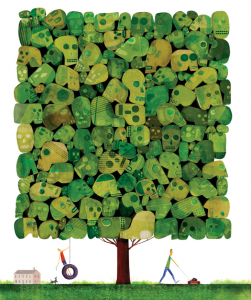Yesterday Nature published a study of a ~55,000 year old cranium which shows that anatomically modern humans (“AMH”), presumably migrating out of Africa, were in the Levantine corridor at a time when genetic data indicate humans were interbreeding with Neanderthals. Because Neanderthals were also present in the Levant near this time, the cranium may represent the African group that first encountered Neanderthals, mixed with them, and gave rise to the hybrid ancestral or “modern” populations that later colonized Europe and large parts of Asia. This is a classic example of the right kind of fossil being in the right place at the right time. The presence of this AMH population had been hypothesized, based on genetic and other data, but direct evidence had been lacking until now.
So here we have yet another link, just one of many, in the history of hominin evolution. It’s a great story, but not a simple one. In an editorial accompanying this study, Nature cautions against linear-progressive conclusions:
Where does this fossil fit in? Beware simple answers, and, indeed, simple questions. There is a temptation when discussing human evolution to reconstruct it as a narrative, in which successive species evolved to be more like us, and the more like us they became, the more likely they were to migrate to other parts of the world and replace pre-existing forms.
There are at least four things wrong with this. The first is its rather imperialist framing, in which evolution and replacement can be justified after the fact as a kind of manifest destiny.
The second is that it dismisses any extinct species as inferior and therefore of secondary importance.
The third is that it assumes the existence of an arrow of progress, in which species always evolve towards ourselves, a mistaken view that is too welcoming of spurious conceits such as ‘missing links’, and unwilling to countenance odd side branches such as Homo floresiensis, the peculiar, dwarf hominin (member of the human family) that lived in Indonesia until relatively recent times (see nature.com/hobbit10).
The fourth, and arguably the most important, is that it misrepresents the extreme fragmentation of the fossil record, something that Charles Darwin recognized, with his usual percipience, as a ‘difficulty’ with his theory of evolution by natural selection. Darwin was (as usual) selling himself short. That evolution has happened is no longer in doubt: the shared chemistry and structure of all life, from the meanest microbe to the furriest feline, would be testament to that, even had no fossils ever been found.
While I do not agree that the fourth factor is most important (because the hominin fossil record is quite good, with no major gaps or “missing links”), the third factor is worth emphasizing: the story of hominin evolution is not a linear or ineluctable unfolding toward us. There is no arrow of progress in evolution, whether we are talking about hominins or “religion.”
— Cris


